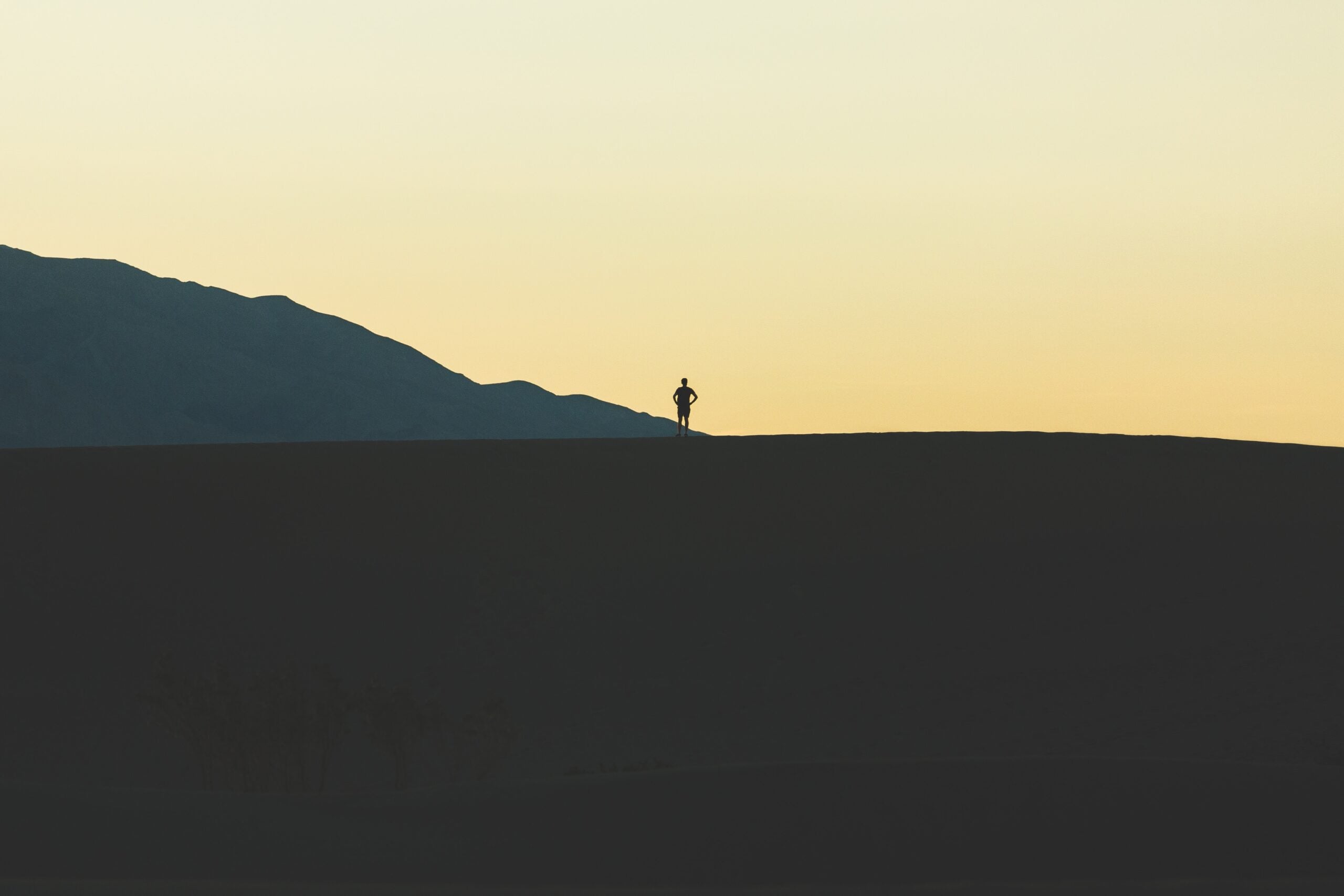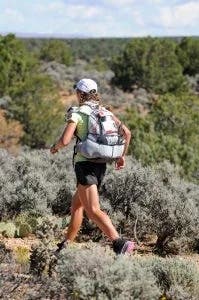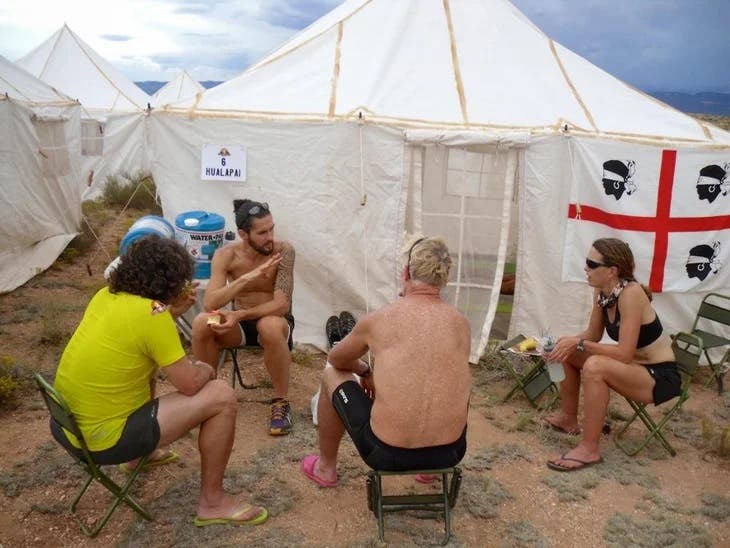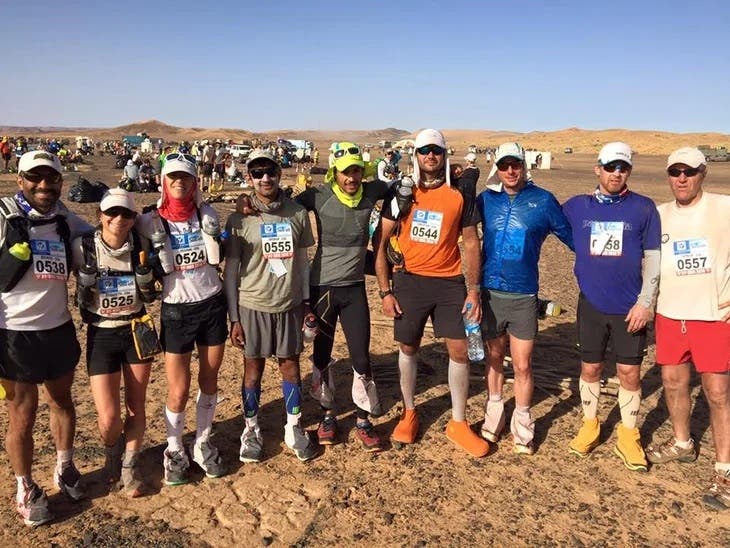5 Ways To Know if a Stage Race is Right For You

(Photo: Pablo García Saldaña/Unsplash)
Imagine this: Yesterday, you ran a marathon-length trail route that beat up your quads and blistered three toes. Today, you’re up for another 25 to 30 miles on an unfamiliar stretch of treacherous trail.
Tomorrow, the real fun begins. Running with a loaded pack, in high altitude and extreme temperature, you’ll go another 50-some miles. Making this week even more interesting, you’re sleeping in a tent with seven ripe-smelling strangers who are your new best friends.
Does this kind of week sound appealing? If so, consider a stage race for your next ultra-distance, trail-running adventure.
Unlike a single-stage, extra-long ultra, which might take multiple days to finish and involve napping along the way, a stage race divides a route into specific distances, or stages, and all participants stop and camp after completing that day’s stage. In many events—the self-supported ones—runners also shoulder the burden of carrying a pack with sleeping gear and a week’s worth of food, which means subsisting on limited calories. Competition is based on cumulative time for the stages.
Most events assign participants to sleep in a communal tent. “Those six to eight tent mates are the really unique part of stage racing,” says Vincent M. Antunez, a U.S. Army major from Texas whose stage-racing resume includes the Grand to Grand Ultra, Marathon Des Sables and all events in the 4Deserts Series.
Tent mates bond and begin to feel like a team or tribe. “Everyone [who shares a tent] tries to help each other make it through the next day,” adds Antunez.
To determine whether you’d enjoy, or at least survive, a challenging stage race, see if the following five characteristics describe you:

1. You can handle—even thrive on—back-to-back long runs.
Stage racing means running long, day after day. Consequently, you should build back-to-back long runs into your training, and adapt to a great deal of time on your feet daily.
RELATED: Training For A Self-Supported Stage Race
A typical 250K (155-mile) stage race organizes its stages with marathon-length runs for Stages 1 – 4, a 50-miler on Stage 5 (usually followed by a rest day), and a short “sprint” of 10 miles or less on Stage 6. The self-supported Grand to Grand Ultra, 170 miles long, puts its long stage in the middle (Stage 3) and divides the mileage the following way: 31, 27, 52, 26, 26, 8.
2. You might not be a great runner, but you’re a darn good hiker and backpacker.
Most stage races have generous cutoff times to allow participants to briskly hike the whole thing if they choose. Even frontrunners do a great deal of hiking, especially in desert-crossing stage races when the terrain features relentless miles of soft sand.
Stage racing rewards a steady, patient approach, along with smart self-care and refueling. Participants who have experience with multi-day backpack trips often finish more reliably than speedy ultrarunners.
“I have seen absolutely phenomenal athletes blow up in the first couple of days [during self-supported stage races],” says Antunez. “They will brag that they finished in the top 10 to 20 during the early stages, but, by day three or four, they are blistered and injured and can’t go on.”

3. Your dream vacation involves sitting around a campfire wearing grubby clothes.
You may run all alone for miles on the trail during a stage race, but at night, you hang out with participants at camp while rehashing the day’s adventure. All of you are quite dirty, because you’ve been running in the same clothes for multiple days, to avoid the weight of carrying extra clothing in your pack. The camps do not provide showers, and even portable toilets with toilet paper are considered a luxury (many stage races offer primitive pit toilets).
Two-time Marathon des Sables competitor Liza Howard of Texas relishes this recovery time at camp, when competitors—unplugged from devices—experience the simple pleasure of conversation. (Events may provide a “cyber tent” with a few shared computers to exchange email once daily, but for the most part, participants are off the grid.)
“I love how the lack of technology [at stage races] forces you to be fully present,” Howard says, and, “I love the built-in downtime of a stage race. I have such a tight schedule around a 100-miler—drive in or fly out, then get home as fast as possible, so I’m not taking time away from family.” At a multiday race, by contrast, “There’s nowhere to get to, nothing to get done between stages; the sitting around and visiting isn’t tinged with guilt.”
RELATED: Is The High Price Of Stage Racing Worth It?
4. You “go with the flow” and take care of yourself while adapting to changing, uncontrollable and unknowable circumstances.
Control freaks won’t enjoy and probably won’t do well at stage racing. Nor will those who heavily rely on aid stations and crews to help them through an ultra.
“When a stage race stretches over an entire week, you have less control over variables that may pop up to affect your performance, such as the weather, possible injuries, digestion or health problems,” says Canadian ultrarunner Stephanie Case, who has finished nine self-supported stage races and won or placed second in several. “If you feel most comfortable when you can plan every detail and anticipate every outcome, stage racing might not be for you.”
RELATED: How To Safely Build Volume
For self-supported stage races, practicing self-reliance and self-care is essential to make it through the next day’s stage. Although the events provide medical staff to assist participants with significant pain and illness, runners are expected to triage their own blisters and “hot spots” created by backpack chafing.

5. You enjoy getting to know people from different geographic regions and cultural backgrounds.
Many stage races attract an international field, and some have “country quotas” to ensure a mix of participants from around the globe. That means, for example, that Americans may be limited to a certain number of spots in the entry field, and participants from other continents fill the remainder.
“Being able to meet and learn about people from all over the world, and see what drives them, is a huge draw to these types of races that you don’t get otherwise,” says Antunez.
Adds Case, “While the 100-mile—or 200-mile—distance is my favorite to race, I much prefer stage racing for the overall experience. At single-stage races, you don’t get a chance to reflect, laugh and cry as much with other competitors. The bonds you form with others [at stage races] are long lasting.”
Stage Races Around the World
The following list provides a sampling of well-established stage races, along with a few smaller, newer or lesser-known ones. Many are sold out already for 2017, but they’ll likely open for registration in 2018.
“Supported” means the event transports participants’ gear and food from campsite to campsite, so runners only carry a smaller daypack for hydration and daytime calories.
“Self-supported” generally means that participants must carry their own food, extra clothing, sleeping gear and mandatory safety items during the week, but the event provides water and communal tents. An asterisks (*) denotes an inaugural event in 2017.
Supported Stage Races
Al Andalus Ultimate Trail, Spain: July, 234K (145 miles)
The Costal Challenge, Costa Rica: February, 230K+ (140 miles-ish)
Desert RATS, Colorado/Utah: June, 143 miles
Himalayan 100, India: October/November, 100 miles.
Ring O’ Fire, an island off North Wales: September, 135 miles.
TransRockies Run, Colorado: August, 120 miles.
Self-Supported Stage Races
4Desert Series, multiple destinations (Namibia, China, Chile, Antarctica, plus one special destination annually): 155 miles.
Beyond the Ultimate Series, multiple destinations (Arctic Sweden, Namibia, Peru, *Nepal): 143 – 155 miles.
Fire & Ice, Iceland: late August – early September (155 miles).
Grand to Grand Ultra/Mauna to Mauna Ultra, Northern Arizona/Southern Utah and Hawai’i: September and May, respectively; 170 miles and 155 miles, respectively.
Marathon Des Sables, Morocco: April 250K (155 miles).
Trans-Pecos Ultra, Texas: October, 170 miles.
Sarah Lavender Smith is contributing editor for Trail Runner, and she competed in the 2012 and 2014 Grand to Grand Ultra stage races.